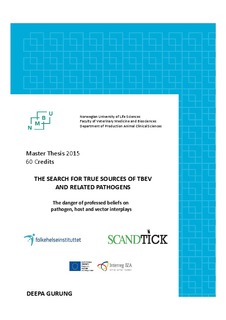| dc.contributor.author | Gurung, Deepa | |
| dc.date.accessioned | 2016-02-29T12:55:41Z | |
| dc.date.available | 2016-02-29T12:55:41Z | |
| dc.date.issued | 2016-02-29 | |
| dc.identifier.uri | http://hdl.handle.net/11250/2380926 | |
| dc.description.abstract | Tick-borne disease in general is among the most important vector-borne diseases that are emerging as a threat to humans and is currently identified as a major health problem in many countries. Tick-borne encephalitis and lyme borreliosis are the main diseases transmitted by Ixodes ricinus ticks in Europe. Besides TBEV (Tick-borne encephalitis virus) and Borrelia burgdorferi sensu lato, I. ricinus is known to transmit other pathogenic microorganisms like- louping ill virus, Anaplasma phagocytophilum, Francisella tularensis, Coxiella burnetii and endosymbionts like-Wolbachia pipientis and Midichloria mitochondrii to humans and animals. Factors like climate change, human behavior and migrating animals are to blame for the spread of tick-borne diseases. The main route of disease transmission is through tick bites, but there is also evidence of infection through alimentary system for serious infectious agents like TBEV.
The knowledge of natural foci and prevalence of these infectious microorganisms is important for risk assessment of human disease. In this study, a total of 3240 nymph and 234 adult ticks were collected from six location sites of three counties of Norway (Hordaland, Vest-Agder and Østfold). The tick samples were analyzed and detected with Real-time PCR, pyrosequencing and direct sequencing to detect the microorganisms. The minimum infection rate or prevalence was calculated from the confirmed observations. Because body fluids of the host animals are valuable epidemiological parameters for TBEV, we also analyzed cow milk and serum from sheep and cows from Hordaland, Vest-Agder and Skedsmokorset. Cow milk was analyzed with PCR and serum with enzyme-linked immunosorbent assay. Two commercial ELISA kits were compared for their sensitivity and specificity.
The study confirms the existence of TBEV endemic foci compared to earlier study. The overall estimated TBEV prevalence in nymphs was 0.12% and in adult 2.13%. The B. burgdorferi s.l. prevalence in adult ticks was 6.41%. A. phagocytophilum prevalence in nymph was 7.96% and in adult 19.23%. Prevalence of W. pipientis in adult ticks was 10.68% and M. mitochondrii 83.33%. We also found TBEV prevalence in a new location in Hordaland county. The detection of TBEV in milk and serum from cows has never been reported in Norway before. | nb_NO |
| dc.description.sponsorship | ScandTick (Interreg IVA project ID.1672226)
Barentsregion project B1412 | nb_NO |
| dc.language.iso | eng | nb_NO |
| dc.publisher | Norwegian University of Life Sciences, Ås | |
| dc.subject | TBEV | nb_NO |
| dc.subject | TBE | nb_NO |
| dc.subject | Borreliosis | nb_NO |
| dc.subject | ELISA | nb_NO |
| dc.subject | PCR | nb_NO |
| dc.title | The search for true sources of TBEV and related pathogens : the danger of professed beliefs on pathogens, host and vector interplays | nb_NO |
| dc.type | Master thesis | nb_NO |
| dc.subject.nsi | VDP::Mathematics and natural science: 400 | nb_NO |
| dc.source.pagenumber | 98 | nb_NO |
| dc.relation.project | ScandTick (Interreg IVA project ID.1672226) | nb_NO |
| dc.description.localcode | M-IPD | nb_NO |
